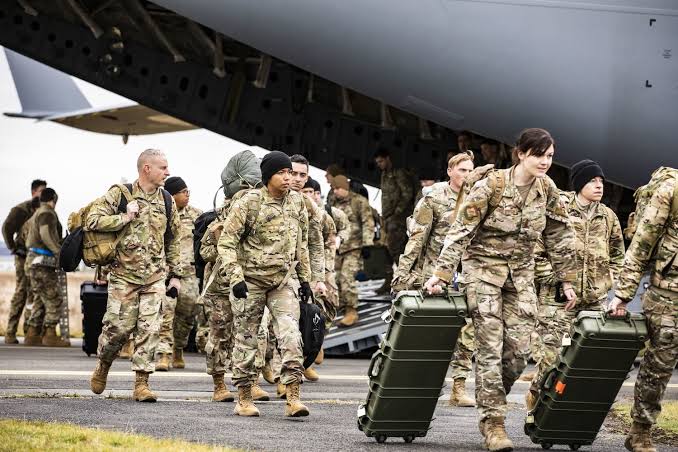Latest
Secrets Exposed: Why The U.S. Has Military Forces In Multiple African Countries — Full List Inside

For decades, the United States has maintained a quiet yet steady presence across several parts of Africa, driven by humanitarian goals, counterterrorism partnerships, and broader global security interests.....KINDLY READ THE FULL STORY HERE▶
Unlike its large-scale military interventions elsewhere, American operations on the continent have largely centred on rescue missions, peacekeeping, medical assistance, and logistical support rather than direct combat.
Recently, U.S. President Donald Trump drew attention to Nigeria after declaring it a “country of particular concern” over reports of widespread violence against Christians.
In a post shared on Truth Social on Friday, October 31, 2025, Trump alleged that radical Islamist groups were behind the mass killings of Christians in Nigeria and called on Congressman Riley Moore and Chairman Tom Cole of the House Appropriations Committee to urgently investigate the matter.
“Christianity is facing an existential threat in Nigeria. Thousands of Christians are being killed. Radical Islamists are responsible for this mass slaughter… The United States cannot stand by while such atrocities occur in Nigeria and other nations,” Trump stated.
The U.S. Africa Command (AFRICOM) oversees America’s small but strategic military deployments across the continent, with operations spanning the Sahel, Horn of Africa, and Gulf of Guinea.
From Somalia’s civil war to Liberia’s Ebola outbreak, the U.S. has repeatedly intervened in moments of crisis—efforts that, while sometimes controversial, have also saved lives and stabilized regions.
America’s presence in Africa continues to expand—not through invasion, but through involvement, partnership, and influence.
Key African Countries with U.S. Military or Humanitarian Involvement
Somalia (1992–1994): The Famine and the Fight
Type of Mission: Humanitarian Relief → Peace Enforcement
Somalia marks one of America’s most significant African operations. Amid a brutal civil war and famine, the U.S. launched Operation Restore Hope in 1992 to ensure food aid reached civilians.
However, escalating clashes with local warlords, culminating in the Battle of Mogadishu (1993), led to heavy losses and the eventual withdrawal of U.S. troops by 1994.
Why the U.S. Intervened:
-
To prevent mass starvation
-
To protect humanitarian aid workers
-
To restore order and stability
Liberia (2014–2015): Fighting Ebola, Not a War
Type of Mission: Humanitarian and Health Assistance
At the height of the Ebola outbreak, Liberia became the centre of a global emergency. The U.S. responded with Operation United Assistance, deploying troops, engineers, and medical experts to help contain the virus.
Why the U.S. Intervened:
-
To support overburdened health systems
-
To prevent the regional spread of Ebola
-
To bolster international containment efforts
Senegal (2014–2015): The Regional Coordination Hub
Type of Mission: Humanitarian and Logistical Support
Senegal served as a logistics base during the Ebola crisis, coordinating U.S. operations across West Africa. Military medics and engineers helped strengthen health systems and ensured quick movement of supplies.
Why the U.S. Intervened:
-
To manage regional emergency response
-
To reinforce medical and logistical infrastructure
Kenya (1998): Embassy Bombing Response
Type of Mission: Disaster Relief and Counterterror Support
Following the August 1998 bombing of the U.S. Embassy in Nairobi, which killed over 200 people, the U.S. deployed emergency teams for rescue, medical treatment, and forensic recovery.
Why the U.S. Intervened:
-
To aid victims and conduct rescue operations
-
To investigate the terror attack
-
To enhance security around U.S. diplomatic missions
Tanzania (1998): Twin Attack Aftermath
Type of Mission: Disaster Relief and Investigation
The same day as the Nairobi bombing, another explosion struck the U.S. Embassy in Dar es Salaam. The U.S. provided medical support, forensic expertise, and security reinforcement in response.
Why the U.S. Intervened:
-
To assist victims of the embassy bombing
-
To support investigations and recovery efforts
-
To secure diplomatic assets in East Africa
West Africa (2014–2015): Regional Health Operations
Type of Mission: Humanitarian and Health Logistics
Beyond Liberia and Senegal, U.S. forces extended Ebola-related missions to Sierra Leone, Ghana, and Nigeria, supporting logistics, medical training, and airlift coordination to stop the spread of the virus.
Why the U.S. Intervened:
-
To contain the Ebola epidemic across the region
-
To strengthen West Africa’s health response capabilities











